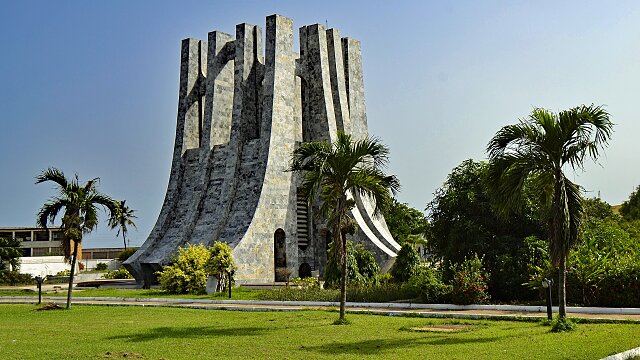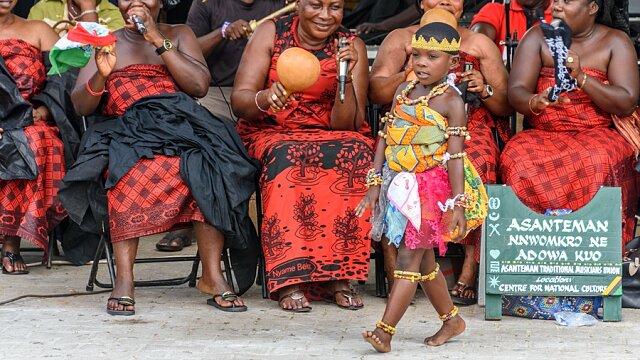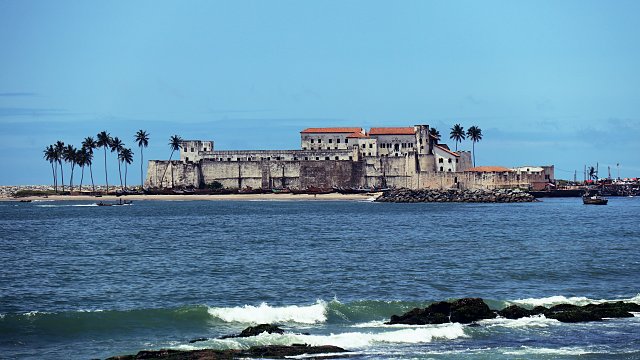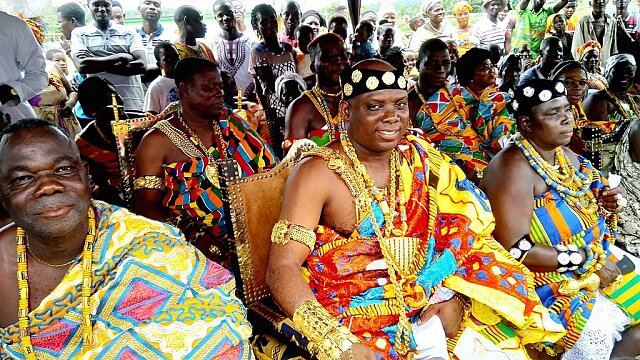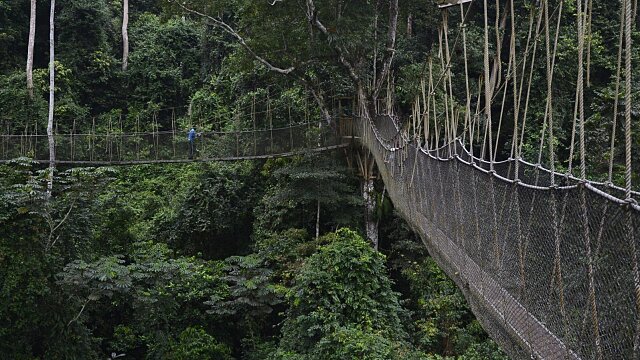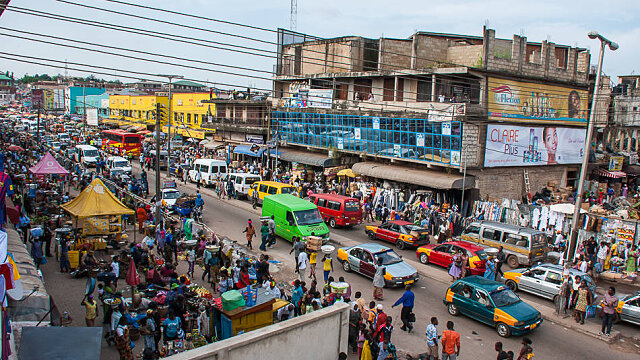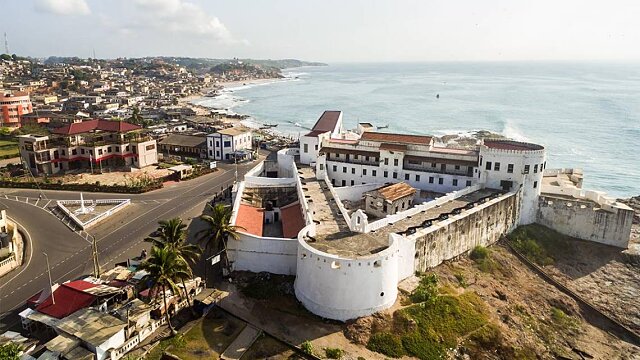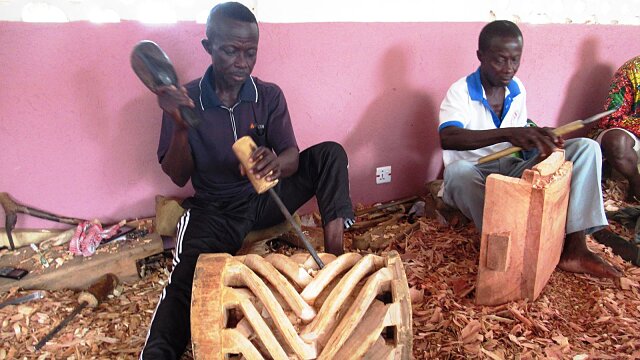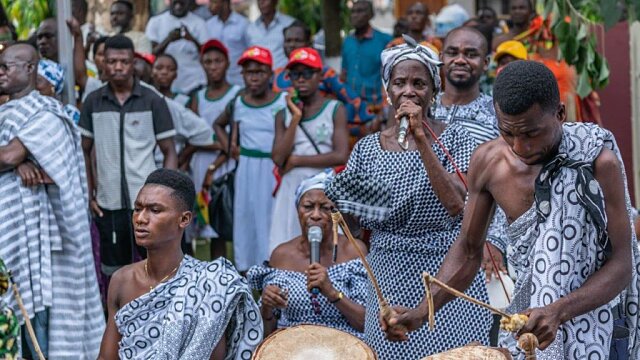Best of Ghana | Oct. 6, 2025
Join us for the Best of Ghana tour starting at $4998 from Washington Dulles International on October 6, 2025. You will see Accra, the National Museum of History, Elmina, Kakum, Cape Coast, Manso Ancestral Slave River Park, Manhyia Palace Museum, the National Cultural Centre, Prempeh II Museum, Kumasi, Akwasidae Festival, Ashanti Craft Villages, and much more!
What's Included
- All Inclusive Pricing
- First Class Hotels
- Deluxe A/C Motor Coaches
- Fuel Surcharges and Gov't Taxes
- International Airfare
- Entrance and Program Fees
- Guided Tours
- Overseas Airport Transfers
- Administrative Fee
- Hotel Gratuities
- Select Meals on Itinerary
Daily Itinerary
Day 1 October 6 – Depart the USA
Depart the USA
Day 2 October 7 – Arrive in Accra
Check into your hotel in Accra for dinner and your overnight stay. (D)
Day 3 October 8 – Accra
Depart for a full-day city tour of Accra. Our first visit to the National Museum of History and Ethnography included exhibits that reflect the heritage of Ghana throughout history and to the present. This Museum houses a varied collection of Ghanaian artifacts. Drive through Old Accra. This is a contrast between Victorian, Dutch, and post-colonial architecture. You will drive past James Fort, built in 1673, Old Accra Square, and the Post Office. Drive by the Ussher Fort, one of three European forts in Accra that have survived the times. Continue to visit the W.E.B. Du Bois Centre for Pan-Africanism; this is the final burial place and home of the prominent American Pan-Africanist Dr. W.E.B. Du Bois, who led the Pan-African Congress between 1919 and 1927. It is currently a Pan African Centre for Culture and it also has a research library and gallery full of manuscripts. Lunch at a local restaurant. Visit the newly redeveloped Dr. Kwame Nkrumah Mausoleum and Park Museum. The Kwame Nkrumah Mausoleum and Memorial Park is in downtown Accra, the capital of Ghana. The memorial complex was dedicated in 1992 and is situated on the site of the former British colonial polo grounds where Ghana’s independence was declared in Accra. The mausoleum, designed by Dr. Don Arthur, houses the bodies of Kwame Nkrumah, who is regarded as the leading founding father of Ghana’s independence and one of the founding fathers of the African Union. His Egyptian Wife, Madam Fathia Nkrumah, is also buried at the mausoleum. The mausoleum is meant to represent an upside-down sword, which in Akan culture is a symbol of peace. It is clad from top to bottom with Italian marble, with a black star at its apex to symbolize unity. A skylight at the top of the mausoleum illuminates the grave. The mausoleum is surrounded by water, a symbol of life. Your last stop for the day is the Arts and Crafts market, where you can view a varied collection of Ghanaian handicraft souvenirs. This offers you an opportunity to try out your bargaining skills on the local vendors and to “shop till you drop.” Return to your hotel in Accra. Dinner is on your own this evening. (B, L)
Day 4 October 9 – Accra – Elmina
Drive along the coastal savannah vegetative cover with several fishing villages and coconut-lined beaches. Of interest along this route are food crop market towns and villages with several pineapple and vegetable stands. Drive through Mankessim and see the status of the “Three Wise Men” likened to the Elephant, Whale, and eagle, which depicts the might and power of the Fante people of Ghana. Arrive and first visit the Elmina Castle, a UNESCO World Heritage Monument, the oldest and largest European structure built in sub-Saharan Africa. This was built by the Portuguese in 1482 and later used as an auction market for enslaved Africans for a comprehensive guided tour. See the slave dungeons and condemned cells where slaves who resisted were incarcerated and starved to death. After lunch, continue to visit Cape Coast Castle, which was initially started by the Swedes in 1652. It served as the headquarters and seat of the British colonial government until 1877. Go on a comprehensive tour of the Castle and the slave dungeons where enslaved Africans were incarcerated. Visit the negotiation hall where our ancestors were bargained for and sold. The rest of your afternoon is free for reflection on our visits to the infamous dungeons. Check into your Beach Resort in Elmina. (B, L)
Day 5 October 10 – Elmina – Kakum
Depart to visit Kakum National Park. Take a walk on the forest Trails with countless trees of medicinal properties. Experience the Canopy Walk suspended 100 feet from the ground for a panoramic view of the flora and fauna of one of the remaining vestiges of the rain forest. Enjoy lunch at a local restaurant and then go for your naming ceremony in a typical fishing village. Today, get immersed in the rich culture of Ghana as you get a unique opportunity to visit a nearby community and interact with the local people. Head to the countryside to witness the traditional way of life first-hand. Meet with the village chief and his elders and enjoy a special cultural performance. Receive a Ghanaian name as you participate in a naming ceremony and learn more about the village life as you take a stroll through the community. Chat with the friendly locals and observe as they go about their daily chores. Today’s experience gives you an invaluable insight into the reality of West Africa’s rural areas. Return to your Beach Resort in Elmina. (B, L)
Day 6 October 11 – Cape Coast – Kumasi
Enjoy breakfast and check out of your resort. Today, you are going to the Ashanti Region, the land of ancient royalty and centuries-old traditions. Ancient Kumasi was the geographic meeting point of two powerful trading systems, the Sudanic Empire across the Sahara to the north and the gold mining Kwaman forest region, which traded with Europeans. Named the Garden City for its tree-lined streets and public flower gardens, Kumasi is the second largest city in Ghana. This region has one of the richest gold mines in the world! Stop en route to Assin Manso Ancestral Slave River Park, which was one of the largest slave markets during the infamous trans- Atlantic slave trade. It was the final link in the slavery route from northern to southern Ghana. The Ndonkor Nsuo (Slave River), is where the captives were oiled, fed and bathed in the waters of their native land one last time. Continue your journey to Kumasi and enjoy lunch at a local restaurant there. After lunch visit the Manhyia Palace Museum. The Manhyia Palace Museum was created within the old residence of Otumfuo Agyeman Prempeh I and Otumfuo Osei Agyeman Prempeh II, the thirteenth and fourteenth Kings of Asante, respectively. This historic building was rehabilitated in 1995 to serve as a museum. Visit the National Cultural Centre and Prempeh II Museum. This museum displays artefacts relating to the Ashanti King Prempeh II, including the king’s war attire, ceremonial clothing, jewelry, protective amulets, personal equipment for bathing and dining, furniture, royal insignia, and some fine brass weights for weighing gold. Constructed to resemble an Ashanti chief’s house, it has a courtyard in front and walls adorned with traditional carved symbols. Check into your hotel in Kumasi. (B, L)
Day 7 October 12 – Akwasidae Festival & Ashanti Craft Villages
After breakfast, depart to participate in the celebration of Akwasidae Festival. This festival falls on and is usually celebrated on a Sunday in Kumasi and other Akan speaking communities who owe allegiance to the King of Ashanti. This is celebrated every 42 days. This is a colorful, scenic and unique event where people gather from afar, many in traditional costumes, come to greet their King on the throne at the royal court, and people bring gifts to pay homage to the King. Join the local folks and international visitors to celebrate Akwasidae festival. This will offer you opportunity to interact with the local chiefs dressed in the colourful Traditional cloth. The Akans (the largest ethnic group in Ghana) annual calendar is divided into nine parts, each lasting approximately six weeks (42 traditional days). On this day, the Asantehene (King of Ashanti) meets his subjects and subordinate chiefs in the courtyard of the Manhyia Palace. The King holds a durbar on the occasion of the festival, and subjects have the opportunity to pay homage to him. Participants of the parade include drummers, folk dancers, horn-blowers and praise singers paying homage to the ancestors. Enjoy lunch at a local restaurant. Continue after lunch to visit a few Ashanti crafts villages including, Ahwiaa – the woodcarver’s village specializing in woodcarving such as the Ashanti stools, fertility dolls and walking sticks and Ntonso - noted for its indigenous artisans whose expertise lie in Adinkra textile printing using traditional symbols that express the spiritual, moral, political and socio-cultural philosophies of the Akan people. In the Ntonso Adinkra village you will be able to try your hand at creating your own designs. From here we will visit Adanwomase well known for the traditional Kente cloth weaving. Observe weavers exhibit their skills in producing the clothes adorned some of which are a preserve for the Ashanti Kings. You can have lessons and try your hands at Kente weaving and Adinkra stamping using centuries old methods. The rest of day is free to relax and enjoy a sundown drink after you return to your hotel in Kumasi. (B, L)
Day 8 October 13 – Kumasi – Accra
After breakfast, it is time to depart Kumasi and return to Accra. Stop en route a village community along the Kumasi – Accra highway to interact with people in the community and experience a bit of the village lifestyle. Continue your journey to Accra. After you check into your room you will have the rest of the day at leisure. Enjoy dinner at a local restaurant after checking in to your hotel in Accra. (B, D)
Day 9 October 14 – Accra – Day at Leisure
You can explore the vibrant city at your own discretion today. You can choose to get a breath of fresh air on the beach or go downtown, hunting for souvenirs, or an art gallery. Stay overnight in Accra. (B)
Day 10 October 15 – Depart & Return to the USA
Enjoy breakfast at your hotel and some time for last-minute shopping this morning before transferring to the airport for your return. You may require an overnight stay at the gateway city. (B)
Day 11 October 16 – Arrive Home
Arrive Home
Departure Dates
-
Monday, October 6, 2025From $4998

